新概念英语第一册 lesson37-38(共108张PPT)
文档属性
| 名称 | 新概念英语第一册 lesson37-38(共108张PPT) | 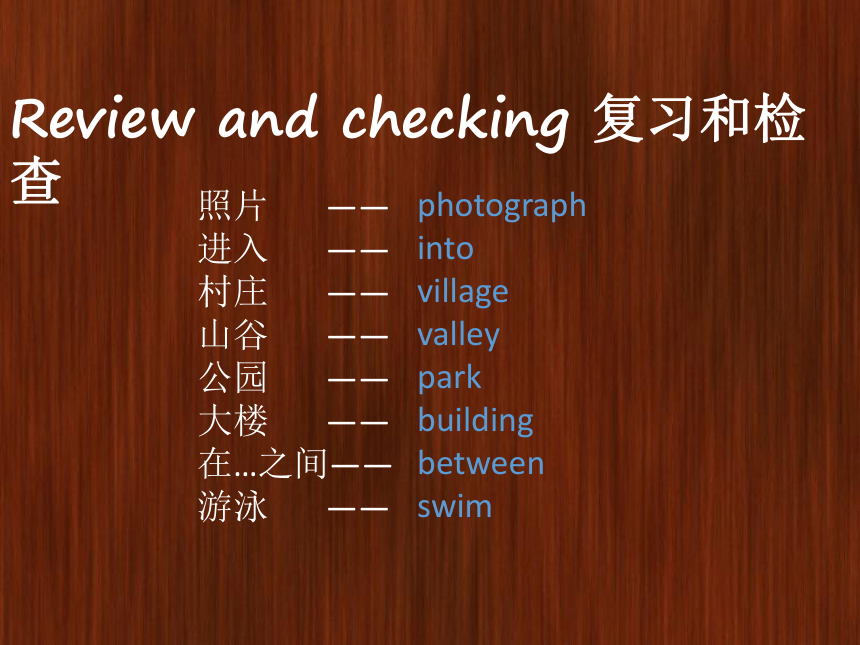 | |
| 格式 | zip | ||
| 文件大小 | 10.6MB | ||
| 资源类型 | 试卷 | ||
| 版本资源 | 新概念英语 | ||
| 科目 | 英语 | ||
| 更新时间 | 2021-06-05 16:09:10 | ||
图片预览

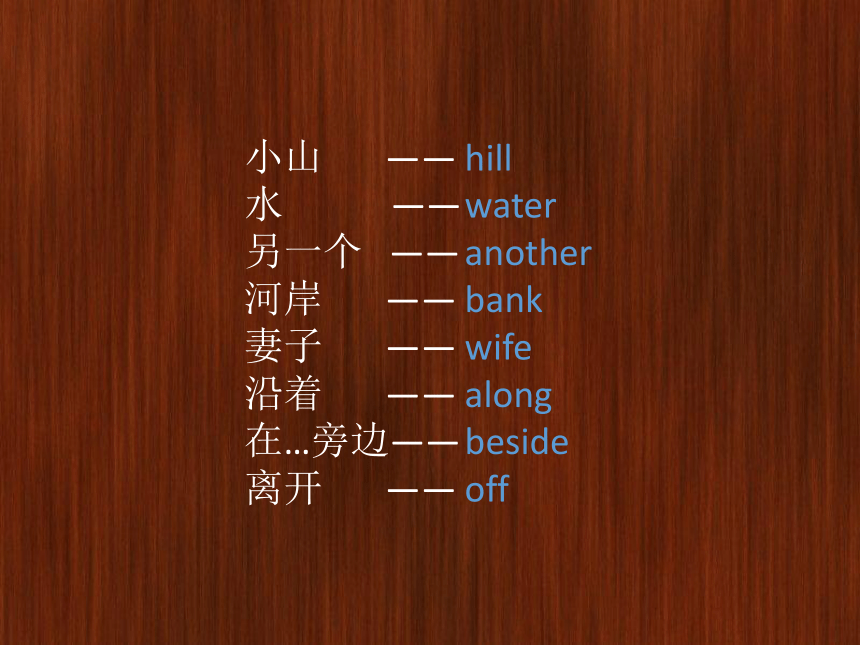
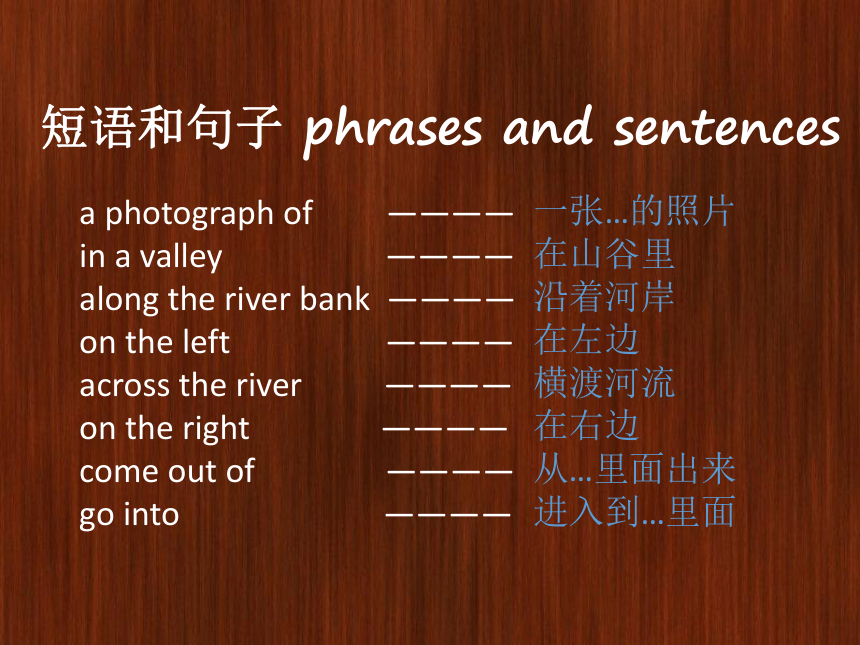

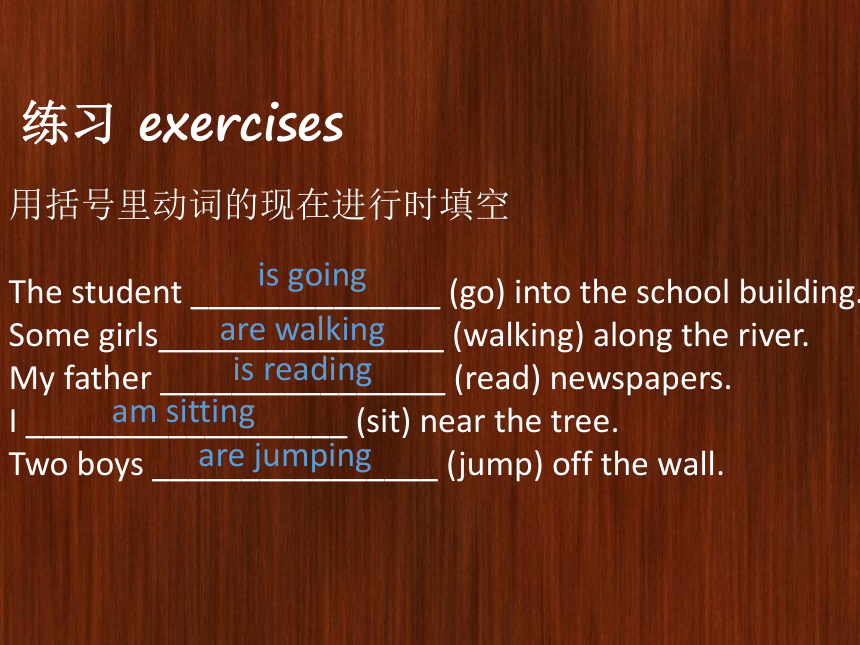
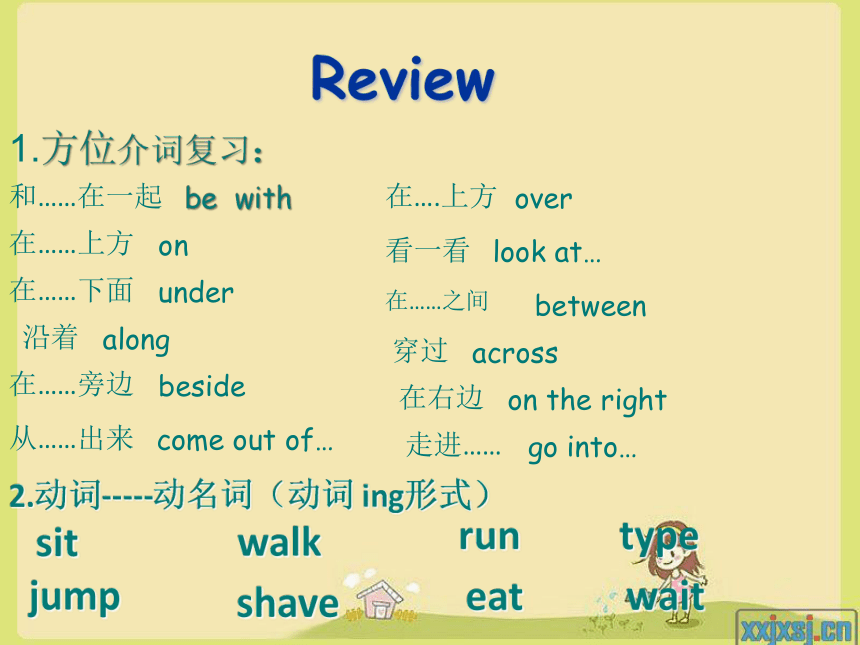
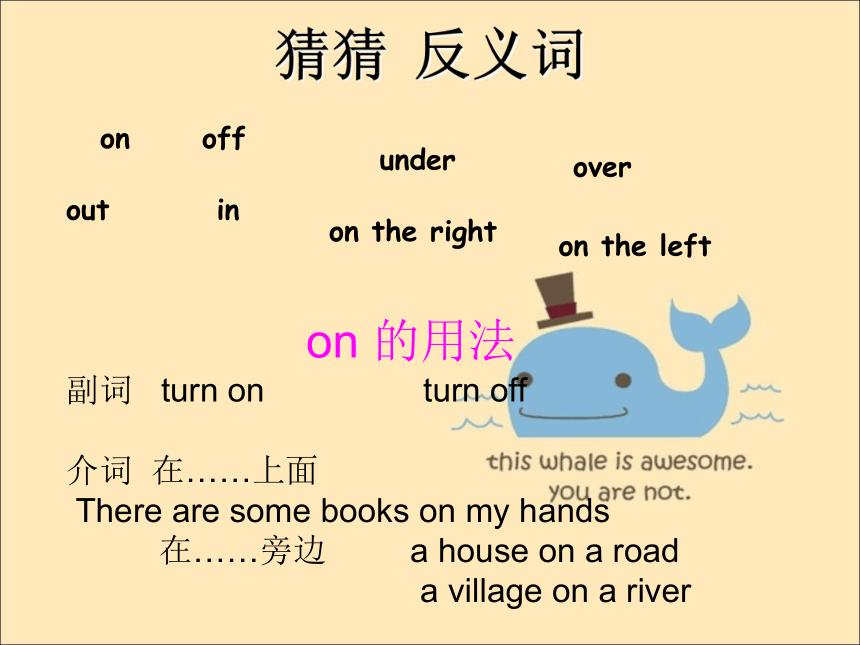
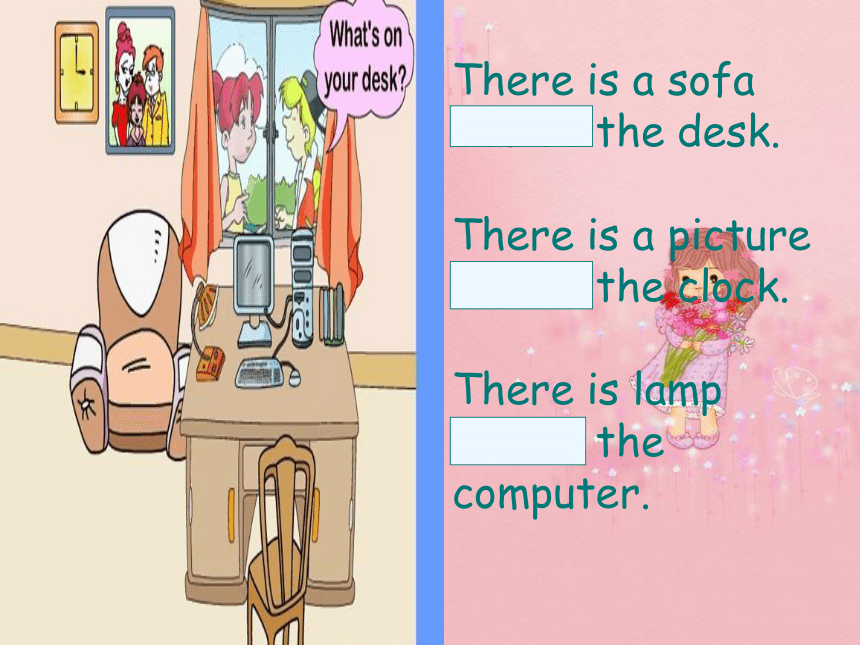
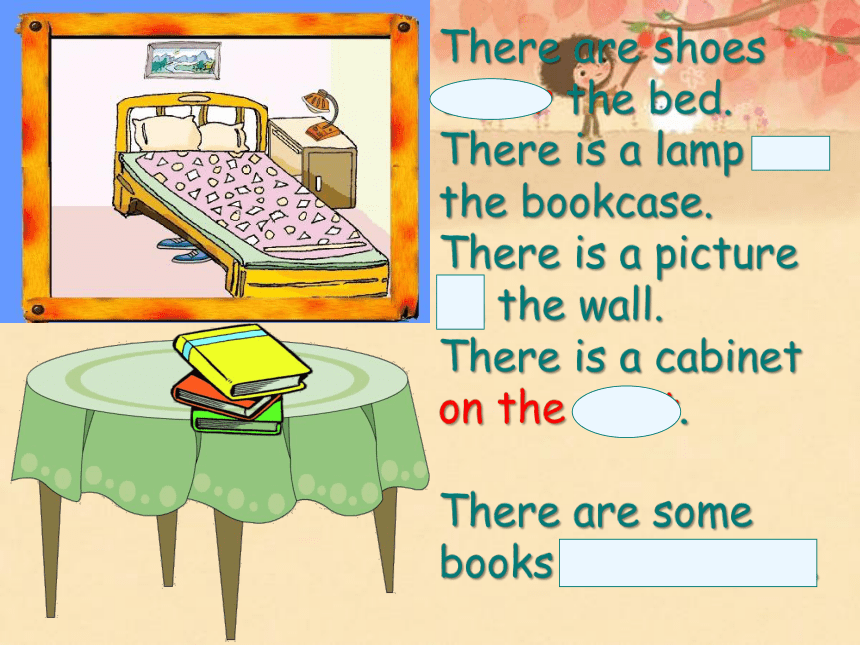
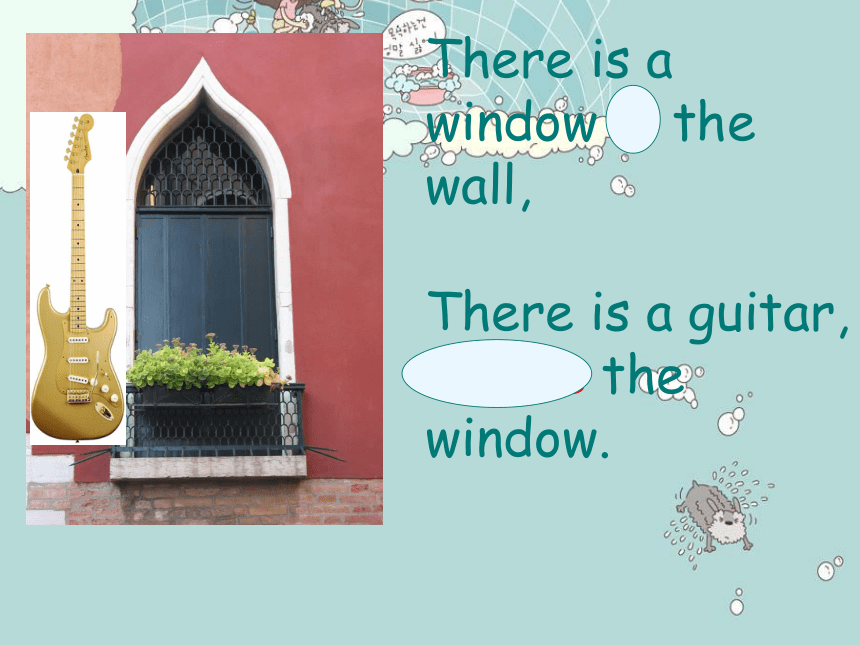
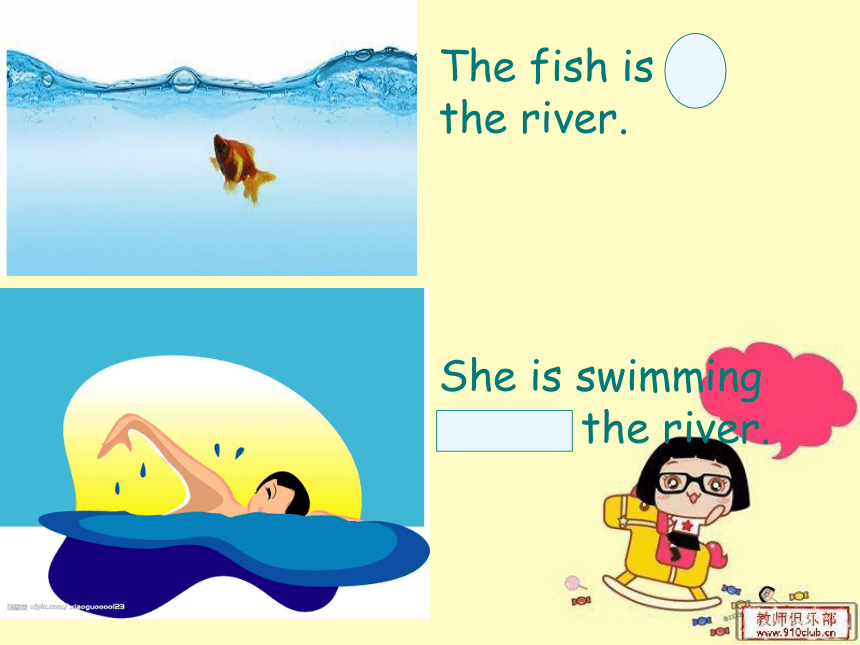
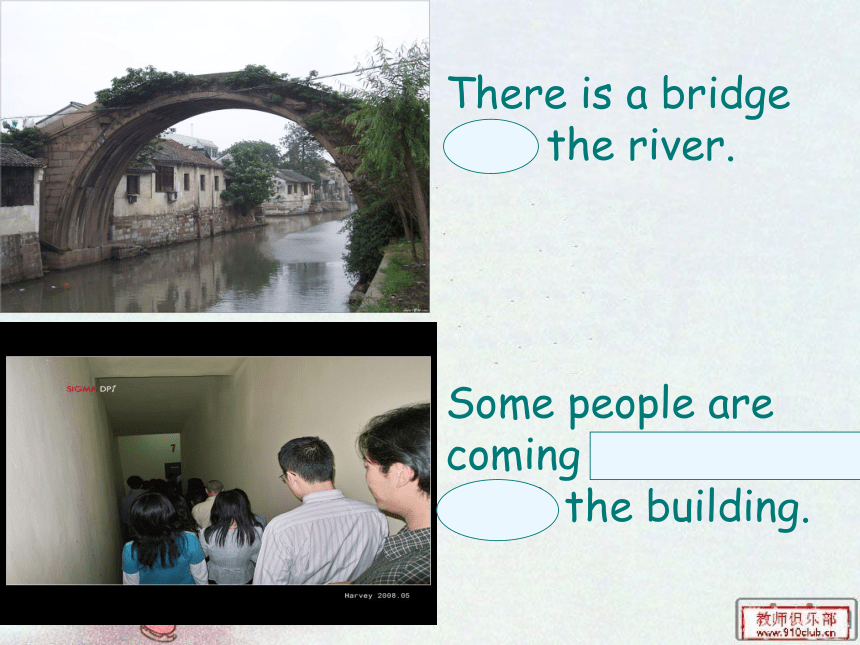
文档简介
(共108张PPT)
Review
and
checking
复习和检查
照片
——
进入
——
村庄
——
山谷
——
公园
——
大楼
——
在…之间——
游泳
——
photograph
into
village
valley
park
building
between
swim
小山
——
水
——
另一个
——
河岸
——
妻子
——
沿着
——
在…旁边——
离开
——
hill
water
another
bank
wife
along
beside
off
短语和句子
phrases
and
sentences
a
photograph
of
————
in
a
valley
————
along
the
river
bank
————
on
the
left
————
across
the
river
————
on
the
right
————
come
out
of
————
go
into
————
一张…的照片
在山谷里
沿着河岸
在左边
横渡河流
在右边
从…里面出来
进入到…里面
练习
exercises
The
girl
is
walking
________
the
river
bank.
The
building
is
_________
two
roads.
This
is
another
photograph
_________
my
family.
My
house
is
_________
a
school
building.
Some
children
are
going
_________
the
park.
along
between
of
beside
into
练习
exercises
用括号里动词的现在进行时填空
The
student
______________
(go)
into
the
school
building.
Some
girls________________
(walking)
along
the
river.
My
father
________________
(read)
newspapers.
I
__________________
(sit)
near
the
tree.
Two
boys
________________
(jump)
off
the
wall.
is
going
are
walking
is
reading
am
sitting
are
jumping
Review
1.方位介词复习:
和……在一起
be
with
在….上方
over
在……上方
on
look
at…
看一看
在……下面
under
在……之间
between
沿着
along
穿过
across
beside
在……旁边
在右边
on
the
right
come
out
of…
从……出来
走进……
go
into…
2.动词-----动名词(动词
ing形式)
sit
walk
run
jump
shave
eat
type
wait
猜猜
反义词
over
on
off
in
under
on
the
right
out
on
the
left
on
的用法
副词
turn
on
turn
off
介词
在……上面
There
are
some
books
on
my
hands
在……旁边
a
house
on
a
road
a
village
on
a
river
There
is
a
sofa
beside
the
desk.
There
is
a
picture
beside
the
clock.
There
is
lamp
beside
the
computer.
There
are
shoes
under
the
bed.
There
is
a
lamp
on
the
bookcase.
There
is
a
picture
on
the
wall.
There
is
a
cabinet
on
the
right.
There
are
some
books
on
the
table.
There
is
a
window
in
the
wall,
There
is
a
guitar,
beside
the
window.
The
fish
is
in
the
river.
She
is
swimming
across
the
river.
There
is
a
bridge
over
the
river.
Some
people
are
coming
out
of(
into)
the
building.
He
is
walking
along
the
banks
of
the
river
There
is
a
house
between
two
hills.
Lesson37
Making
a
bookcase
Lesson
38
What
are
you
going
to
do
?
work
[w?:k]
v.
工作
hard
[hɑ:d]
adv.努力地
make
[me?k]
v.
做
bookcase
[?b?k-
ke?s]
n.书橱,书架
hammer
[?h?m?]
n.锤子
paint
[pe?nt]
v.上漆,涂
pink
[p??k]
n&adj.粉红色;粉红色的
favourite
[?fe?v?r?t]
adj.最喜欢的
vocabulary
1.
homework?
[‘h?umw?:k]
n.作业
do
one’s
homework
2.
listen?
[‘lis?n]
v.听
Listen
to
me
3.
dish?
[di?]
n.盘子,碟子
dishes
Do
the
dishes/wash
the
dishes
vocabulary
Work
job区别
work
是泛指的工作,是不可数名词
homework
家庭作业
housework
家务
动词用
do
job
指具体的工作,为可数名词。
What’s
your
job?
I
am
a
singer.
work
hard
hard-working
hard
(1)adv.努力地
副词常后置修饰动词,或形容词后修饰
努力地工作
work
hard
努力地工作
study
hard
努力地学习
(2)adj.
辛苦的,困难的,坚硬的,努力的
形容词常放名词前,修饰名词
hard
work
艰苦的工作
hard-working
勤奋的
hard-hearted
心肠硬的
e.g.
他是个勤奋的男孩。
e.g.
我们必须努力工作
e.g.
那是艰苦的工作
He
is
a
hard-working
boy.
We
must
work
hard.
That’s
hard
work.
make
[meik]做
make
the
bed
make
a
meal
make
tea
铺床
做饭
沏茶
make
[meik]
v.
1,制造,使成为,产生。
2,整理,准备。
make
a
cake
make
a
dress
做书架
make
a
bookcase
整理床铺:
make
the
bed
中国制造:
Made
in
China
e.g.
他的妈妈正在做饭。
e.g.
他们的父母正在做饭。
His
mother
is
making
a
meal.
Their
parents
are
making
the
meal.
make
it
:
succeed
成功了
e.g.
我能成功!!
make
up
化妆
e.g.
她正在化妆。
I
can
make
it.
She
is
making
up
her
face
now.
hammer
n.
锤子
['h?m?]
paint
[peint]上漆,
涂,画画
painter
画家,粉刷匠
Wet
paint
油漆未干
paint
[pe?nt]
v.上漆,涂
v.
上漆,涂
paint
the
wall
white
把墙涂成白色
n.
油漆;涂料;颜料
Wet
Paint!
油漆未干!
paint
v.
painter
n.
粉刷工,画家
painting
n.
油画,水彩画
drawing
n.
素描
picture
n.
泛指各种画,照片
bookcase
['bukkeis]书架
bookshelf
bookworm
书虫/书痴
bookshop
书店
bookmark
书签
pink
[pi?k]粉红色的
Pink
Floyd
平克弗洛伊德
下一页
pink
n.
/adj.
粉红色的
pink
collar
粉领(指跟女性有关的办公室工作)
white
collar
白领
(坐在办公室里工作的人)
blue
collar
蓝领(工人阶级)
in
the
pink
of
health
身体很好
favourite
[?fe?v?r?t]
adj.最喜欢的
favourite=“favorite”=like
best
This
type
of
chocolate
is
my
favourite.
This
is
my
favourite
type
of
chocolate.
这种巧克力是我的最爱。
favourite
adj.
最喜欢的
e.g.
This
is
my
favourite
CD.
这是我最喜欢的CD。
--Am
I
your
favourite
student?
我是你最喜欢的学生吗?
--
Yes,
you
are.
--
No,
you
are
not!
favourite
adj.
最喜欢的
n.
最喜欢的东西
e.g.
These
books
are
my
favourites.
=
These
are
my
favourite
books.
这些是我最喜欢的书。
这是我最喜欢的游戏。(该怎么说呢?)
dish
可数
复:dishes
(1)盘/碟子
wash
the
dishes
洗碗
(2)(一道)菜
We
have
5
dishes
today.
home
+
work
不可数
同理:
housework
家务
do
the
homework
做家庭作业
listen
to
听……
listener
n.
听众;倾听者
listening?[‘lis?ni?]
n.听力
hear
v.
听到
listen
和hear
相比较,前者强调听的过程或目的,
表示“听”;后者强调听的结果,表示“听到”listen
painter
画家
worker
工人
workmate
同事
hear
I
______
the
teacher,but
I
don't
______anything
listen
to
hear
Take
a
break
休息一下
Lesson
37
Making
a
bookcase
做书架
Listen
to
the
recording
and
answer
these
questions:
What
is
George
doing?
What
color
is
George
going
to
paint
the
bookcase?
Who
is
George’s
daughter?
What’s
Susan’s
favourite
color?
watch
the
video
DAN:
You're
working
hard,
George.
What
are
you
doing?
GEORGE:
I'm
making
a
bookcase.
现在进行时
主+be(am
/is/are)+ving
+其他
GEORGE:
Give
me
that
hammer
please,
Dan.
DAN:
Which
hammer?
This
one?
GEORGE:
No,
not
that
one.
The
big
one.
Give
me….
祈使句
(以动词原形开头,表示命令建议L21
L29)
动词后面的人称代词用
宾格
one,
代词,
在这里代指one
hammer
"同名异物"代指前面事物同属一类的事物中的一个
DAN:
Here
you
are.
GEORGE:
Thanks,
Dan.
DAN:
What
are
you
going
to
do
now,
George?
GEORGE:
I'm
going
to
paint
it.
Here
you
are
给你
主+be
going
to
+动词原形
将要做某事
一般将来时
DAN:
What
colour
are
you
going
to
paint
it?
GEORGE:
I'm
going
to
paint
it
pink.
DAN:
Pink!
GEORGE:
This
bookcase
isn't
for
me.
It's
for
my
daughter,
Susan.
Pink's
her
favourite
colour.
paint
上漆,涂
pink
粉色
favourite
最喜欢的
flowers
for
my
mother
make
a
bookcase
for
my
daughter.
Lesson
37
Dan:
You’re
working
hard,
George.
What
are
you
doing?
George:
I’m
making
a
bookcase.
George:
Give
me
a
hammer
please,
Dan.
Dan:
Which
hammer?
This
one?
George:
No,
not
that
one.
The
big
one.
Dan:
Here
you
are.
George:
Thanks,
Dan.
Dan:
What
are
you
going
to
do
now,
George?
George:
I’m
going
to
paint
it.
Dan:
What
colour
are
you
going
to
paint
it?
George:
I’m
going
to
paint
it
pink.
Dan:
Pink!
George:
This
bookcase
isn’t
for
me.
It’s
for
my
daughter,
Susan.
Pink’s
her
favourite
colour.
课文解析
You're
working
hard,
George.
你干得真辛苦,乔治。
在这句话中hard是一个副词,修饰动词work,有“努力地”,“费劲地”的意思。hard还常常与表示动词、举止的动词连用,如work,listen,play,try等,用来加强动作的强度,常译成“拼命地”。
give
me
that
hammer
please,
Dan.
请把那把锤子拿给我,丹。
give
sb.
sth.
=
give
sth.
to
sb.
双宾语
有些动词后可以跟两个宾语,一个直接宾语,一个间接宾语.一般情况下,物是直接宾语,人是间接宾语。
1、人要用代词的宾格
2、双宾语句型直接宾语的用法可以转换成:把物提前+to+人
What
are
you
going
to
do
now,
George?
I'm
going
to
paint
it.
你现在打算干什么,乔治?
我打算把它漆一下。
be
going
to,是打算、准备、按计划在最近做某事,表示将来。参见本课语法部分。
What
colour
are
you
going
to
paint
it?
I'm
going
to
paint
it
pink.
你打算把它漆成什么颜色的?
乔治:我想漆成粉红色。
Be
going
to
do的特殊疑问句。
Paint
it
pink.
漆成粉红色。
it指bookcase,是宾语,pink是宾语补足语。
This
bookcase
isn't
for
me.
It's
for
my
daughter,
Susan.
Pink's
her
favourite
colour.
这个书架不是为我做的,
是为我女儿苏珊做的。
粉红色是她最喜欢的颜色。
For是“为了”的意思。
pink's
=
pink
is。
give
me
that
hammer
please,
Dan.
Which
hammer?
This
one?
No,
not
that
one.
The
big
one.
祈使句
代词:指代前文出现的单数名词
This
bookcase
isn’t
for
me.
It’s
for
my
daughter,
Susan.
Pink’s
her
favourite
colour.
prep.
表对象:给
FOR
prep.
给。。。的(后面的代词用宾格)
1.
That
book
is
for
him.
???????????????????????
2.
The
socks
are
not
for
her.
????????????????????
3.这些信是我的吗?
???????????????????????
是的,它们是。
???????????????????????
4.它是给我的儿子Peter的。
????????????????????????
那本书是给他的。
那双袜子不是给她的。
Are
these
letters
for
me?
Yes,
they
are.
It's
for
my
son,
Peter.
语法
我打算看书。
他们打算步行上学。
I
am
going
to
read.
They
are
going
to
walk
to
school.
一般将来时将要做的事
它的结构是:
主语+be
going
to+动原
be
going
to
是结构,表示“计划,打算”做某事\
肯定句:I
am
going
to
make
the
bed.
否定句:I
am
not
going
to
make
the
bed.
一般疑问句:
--Are
you
going
to
make
the
bed?
--Yes,
I
am.
/No,
I
am
not.
特殊疑问句:
What
are
you
going
to
do?
1.我今晚会给你电话。(call)
2.
她会在8点起床。(get
up)
3.
他们将会煮晚餐。(cook
dinner)
4.
他将会去银行。(go
to
the
bank)
I’m
going
to
call
you
tonight.
She
is
going
to
get
up
at
8.
They
are
going
to
cook
dinner.
He
is
going
to
go
to
the
bank.
我不准备吃午餐了。(have
lunch)
她们不打算去逛街了。(go
shopping)
他们不打算去爬山了。(climb
the
hill)
她不准备去关灯了。(turn
off
the
light)
I’m
not
going
to
have
lunch.
They
are
not
going
to
go
shopping.
They
are
not
going
to
climb
the
hill.
She
is
not
going
to
turn
off
the
light.
1.I’m
going
to
call
you
tonight.
2.She
is
going
to
get
up
at
8.
3.They
are
going
to
cook
dinner.
4.He
is
going
to
the
bank.
变成一般疑问句:
用法:
1.
表示打算要做某事。
e.g.
My
sister
is
going
to
visit
her
teacher
tomorrow.
我的姐姐打算去拜访她的老师。
e.g.
I
am
going
to
put
the
bookcase
beside
the
desk.
我打算把书橱放在书桌旁边。
用法:
2.
表示按计划,安排要发生的事。
e.g.
The
meeting
is
going
to
begin
at
nine.
会议将在9点开始。
用法:3.表示某件事即将要发生。
e.g.
It’s
going
to
rain.
天要下雨了!
e.g.
She’s
going
to
faint!
她要晕倒了!
e.g.
The
books
are
going
to
fall.
书要掉下来了!
make
a
bookcase
e.g.
我打算做一个书橱。
cook
a
meal
e.g.
她要做一顿饭。
I
am
going
to
make
a
bookcase.
She
is
going
to
cook
a
meal.
疑问句:把系动词提前
你打算把书橱刷成粉色的吗?
--
Yes,
I
am.
No,
I
am
mot.
---
他要洗车吗?
--
Are
you
going
to
paint
the
bookcase
pink?
Is
he
going
to
clean
the
car?
否定句:系动词后面加
not
e.g.
他们不打算到那去工作。
e.g.
她不打算把她的新笔给他。
They
are
not
going
to
work
there.
She
isn’t
going
to
give
her
new
pen
to
him.
特殊疑问句
e.g.
你(们)/我们/他们要做什么?
e.g.
他/她打算做什么?
What
are
you/we/they
going
to
do?
What
is
he/she
going
to
do?
e.g.
你打算把书橱涂上什么颜色?
e.g.
你的妈妈打算要做什么?
What
colour
are
you
going
to
paint
the
bookcase?
What
is
your
mother
going
to
do?
例
我准备回家。
I
am
going
to
go
home。
他准备刮胡子。
He
is
going
to
shave.
他们准备扫地。
They
are
going
to
sweep
the
floor.
天(将)要下雨了。
It’s
going
to
rain.
be
动词口诀
我用
am,你用
are,
is
连着他她它,
单数名词用
is,
复数名词都
are,
变疑问,往前移,句末问号莫丢弃,
变否定,更容易,be
后
not
莫忘记,
疑问否定任你变,句首大写要牢记。
Practice
1.
我打算做一个书橱。
???????????????????????
2.她要做一顿饭。
????????????????????????
3.他们要去江里游泳。
????????????????????????????
4.你打算把书橱刷成粉色的吗?
????????????????????????????
肯定回答:
??????????????
否定回答:
??????????????
I
am
going
to
make
a
bookcase.
She
is
going
to
cook
a
meal.
They
are
going
to
swim
in
the
river.
Are
you
going
to
paint
the
bookcase
pink?
Yes,
I
am.
No,
I
am
not.
按要求对下列句子进行句型转换
1.He
is
going
to
take
computer
lessons
this
afternoon.
(改为
否定句)
2.They
are
going
to
take
a
trip
in
this
summer
vacation.
(变为一般疑问句)
3.I
am
going
to
do
my
homework
tomorrow?
(对画线部分提问)
He
isn't
going
to
take
computer
lessons
this
afternoon.
Are
they
going
to
take
computer
lessons
this
afternoon?
What
are
you
going
to
do
tomorrow?
make
a
bookcase
paint
pink
work
hard
for
daughter
big
hammer
Lesson
38
What
are
you
going
to
do?
What
are
you
doing
now?
What
is
he
doing?
He
is
working
What
is
baby
doing?
The
baby
is
sleeping
What
is
he
doing?
He
is
shaving
What
is
he
doing?
He
is
typing
What
are
they
going
to
do?
They
are
going
to
go
shopping.
What
is
she
going
to
do?
She
is
going
to
write.
What
is
he
doing?
He
is
writing.
What
is
the
girl
going
to
do?
She
is
going
to
paint
.
What
is
the
boy
doing?
He
is
painting
What
are
you
going
to
do?
I
am
going
to
do
our
homework.
What
are
you
doing
now?
Now
I
am
doing
our
homework.
What
are
you
going
to
do
?
I
am
going
to
shave.
What
are
you
doing
now?
Now
I
am
shaving.
一般将来时
pk
现在进行时
一般将来时:
be
going
to
do
有计划,将要,打算,有准备做······
(打算做还没做)
现在进行时:
be
doing
现在正在做……
(正在做)
现在进行时
主+be+v-ing
+其他
Q:
what
are
you
doing
now?
时间状语:now
v.
look,
listen
一般将来时
主+be+going+to+动词原形+其他
Q:
what
are
you
going
to
do?
(表将来的时间状语)
:tomorrow
next
year/week/Sunday
Exercises
A
Example:
What
are
you
doing?
Be
动词由主语决定,you是主语
提示:
第一人称用am
(I)
第二人称,第一第三人称复数用are
(you,
we,
they)
第三人称单数用is。(he,
she,
it)
Exercises
A
1.
are,
are
2.
are,
are
3.
is,
is
4.
are,
am
Exercises
B
提示:
提问:
你准备做什么?
回答:
我准备做…
注意:问句中和答句中be动词的变化。
Exercises
B
1.
What
are
you
going
to
do?
I’m
going
to
shave.
What
are
you
doing
now?
I’m
shaving
now.
2.
What
are
you
going
to
do?
I’m
going
to
wait
for
a
bus.
What
are
you
doing
now?
I’m
waiting
for
a
bus.
3.
What
are
you
going
to
do?
I’m
going
to
do
my
homework.
What
are
you
doing
now?
I’m
doing
my
homework.
4.
What
are
you
going
to
do?
I’m
going
to
listen
to
the
stereo.
What
are
you
doing
now?
I’m
listening
to
the
stereo.
stereo(L24)
[‘sti?ri?u]
立体声音响
5.
What
are
you
going
to
do?
I’m
going
to
wash
the
dishes.
What
are
you
doing
now?
I’m
washing
the
dishes.
一.按照例句说句子,将它们写下来,并划分出句子的成分。
例如:
do
my
homework-----What
are
you
going
to
do?
I’m
going
to
do
my
homework.
----What
are
you
doing?
I’m
doing
my
homework.
1.
listen
to
the
stereo----_______________________________________________
----________________________________________________.
2.
wash
the
dishes----__________________________________________________.
----___________________________________________________.
What
are
you
going
to
do?
I’m
going
to
listen
to
the
stereo.
What
are
you
doing
?
I’m
listening
to
the
stereo.
What
are
you
going
to
do
?
I’m
going
to
wash
the
dishes.
What
are
you
doing
?
I’m
washing
the
dishes.
二.
用am,
is或are填空。(2分钟)
1.What
____
you
doing?
We
____
reading.
2.
What
____
you
doing?
I
____
washing
the
dishes.
3.
What
__
they
doing?They
__
doing
their
homework.
4.
What
__
he
doing?He
_
working
hard.
三.明星大挑战,看谁最闪亮!(2分钟)
(
)1---Listen!
Who
______
piano
---My
sister.
A.plays
B.is
playing
C.plaies
D.is
playying
(
)2.---What's
your
brother
doing
in
the
park
now?---He
______
a
kite.
A.flies
B.flew
C.is
flying
D.will
fly
(
)3.
---You've
left
the
light
on.
---Oh,
sorry.
______
to
turn
it
off.
A.
I've
gone
B.I'm
going
C.I
go
D.I
will
going
(
)4.I
______
my
homework
while
my
parents
______
the
bed
for
me.
A.am
making/are
doing
B.am
doing/are
making
C.am
making/are
making
D.am
doing/are
doing
(浙江中考)
(
)5.The
child
______
his
mother
carefully
but
he
can't
_______
anything.
A.listens/hear
B.is
listening
to/hear
C.hears/listen
D.hears/listen
to
(江西中考)
四.Mr.
Brown
研制出了一个新型机器人,机器人对Mr.
Brown
的工作环境还不是很熟悉,所以它对Mr.
Brown
提了很多的问题。(2分钟)
例如:Is
Tom
painting
the
bookcase
now?
(N)
No,
he
isn’t,
but
he’s
going
to
paint
the
bookcase.
Are
you
putting
on
your
coat?
(Y)
Yes,
I
am.
你能帮他回答下面的问题吗?
1.
Is
she
washing
the
dishes?
(N)__________________________________
2.
Are
they
doing
their
homework?
(Y)________________________________
3.
Is
she
typing
any
letters?
(N)
______________________________________
4.
Are
they
reading
magazines?(N)____________________________________
No,
she
isn’t.
But
she
is
going
to
wash
the
dishes.
Yes,
they
are.
No,she
isn’t.
But
she
is
going
to
type
aome
letters.
No,
they
aren’t.
But
they
are
going
to
read
magazines.
五.用所给动词的适当形式填空
(2
分钟)
1
George________________(make)
a
bookcase
now.
2
I________________(do)
my
homework
now.
3.
We
_____________(wait)
for
the
bus
tomorrow.
Homework
1、思维导图整理笔记,发到群里;
(周一晚上前完成)
2、把P74、76页的单词抄写1遍,听写一遍,发到群里;(周二)
3、听磁带,读背Lesson37,发到群里;(周三)
4、预习一下Lesson39的对话,尽量读熟;(周四)
5、完成L37-38的练习册作业。(周五)
(周末上课检查)
Review
and
checking
复习和检查
照片
——
进入
——
村庄
——
山谷
——
公园
——
大楼
——
在…之间——
游泳
——
photograph
into
village
valley
park
building
between
swim
小山
——
水
——
另一个
——
河岸
——
妻子
——
沿着
——
在…旁边——
离开
——
hill
water
another
bank
wife
along
beside
off
短语和句子
phrases
and
sentences
a
photograph
of
————
in
a
valley
————
along
the
river
bank
————
on
the
left
————
across
the
river
————
on
the
right
————
come
out
of
————
go
into
————
一张…的照片
在山谷里
沿着河岸
在左边
横渡河流
在右边
从…里面出来
进入到…里面
练习
exercises
The
girl
is
walking
________
the
river
bank.
The
building
is
_________
two
roads.
This
is
another
photograph
_________
my
family.
My
house
is
_________
a
school
building.
Some
children
are
going
_________
the
park.
along
between
of
beside
into
练习
exercises
用括号里动词的现在进行时填空
The
student
______________
(go)
into
the
school
building.
Some
girls________________
(walking)
along
the
river.
My
father
________________
(read)
newspapers.
I
__________________
(sit)
near
the
tree.
Two
boys
________________
(jump)
off
the
wall.
is
going
are
walking
is
reading
am
sitting
are
jumping
Review
1.方位介词复习:
和……在一起
be
with
在….上方
over
在……上方
on
look
at…
看一看
在……下面
under
在……之间
between
沿着
along
穿过
across
beside
在……旁边
在右边
on
the
right
come
out
of…
从……出来
走进……
go
into…
2.动词-----动名词(动词
ing形式)
sit
walk
run
jump
shave
eat
type
wait
猜猜
反义词
over
on
off
in
under
on
the
right
out
on
the
left
on
的用法
副词
turn
on
turn
off
介词
在……上面
There
are
some
books
on
my
hands
在……旁边
a
house
on
a
road
a
village
on
a
river
There
is
a
sofa
beside
the
desk.
There
is
a
picture
beside
the
clock.
There
is
lamp
beside
the
computer.
There
are
shoes
under
the
bed.
There
is
a
lamp
on
the
bookcase.
There
is
a
picture
on
the
wall.
There
is
a
cabinet
on
the
right.
There
are
some
books
on
the
table.
There
is
a
window
in
the
wall,
There
is
a
guitar,
beside
the
window.
The
fish
is
in
the
river.
She
is
swimming
across
the
river.
There
is
a
bridge
over
the
river.
Some
people
are
coming
out
of(
into)
the
building.
He
is
walking
along
the
banks
of
the
river
There
is
a
house
between
two
hills.
Lesson37
Making
a
bookcase
Lesson
38
What
are
you
going
to
do
?
work
[w?:k]
v.
工作
hard
[hɑ:d]
adv.努力地
make
[me?k]
v.
做
bookcase
[?b?k-
ke?s]
n.书橱,书架
hammer
[?h?m?]
n.锤子
paint
[pe?nt]
v.上漆,涂
pink
[p??k]
n&adj.粉红色;粉红色的
favourite
[?fe?v?r?t]
adj.最喜欢的
vocabulary
1.
homework?
[‘h?umw?:k]
n.作业
do
one’s
homework
2.
listen?
[‘lis?n]
v.听
Listen
to
me
3.
dish?
[di?]
n.盘子,碟子
dishes
Do
the
dishes/wash
the
dishes
vocabulary
Work
job区别
work
是泛指的工作,是不可数名词
homework
家庭作业
housework
家务
动词用
do
job
指具体的工作,为可数名词。
What’s
your
job?
I
am
a
singer.
work
hard
hard-working
hard
(1)adv.努力地
副词常后置修饰动词,或形容词后修饰
努力地工作
work
hard
努力地工作
study
hard
努力地学习
(2)adj.
辛苦的,困难的,坚硬的,努力的
形容词常放名词前,修饰名词
hard
work
艰苦的工作
hard-working
勤奋的
hard-hearted
心肠硬的
e.g.
他是个勤奋的男孩。
e.g.
我们必须努力工作
e.g.
那是艰苦的工作
He
is
a
hard-working
boy.
We
must
work
hard.
That’s
hard
work.
make
[meik]做
make
the
bed
make
a
meal
make
tea
铺床
做饭
沏茶
make
[meik]
v.
1,制造,使成为,产生。
2,整理,准备。
make
a
cake
make
a
dress
做书架
make
a
bookcase
整理床铺:
make
the
bed
中国制造:
Made
in
China
e.g.
他的妈妈正在做饭。
e.g.
他们的父母正在做饭。
His
mother
is
making
a
meal.
Their
parents
are
making
the
meal.
make
it
:
succeed
成功了
e.g.
我能成功!!
make
up
化妆
e.g.
她正在化妆。
I
can
make
it.
She
is
making
up
her
face
now.
hammer
n.
锤子
['h?m?]
paint
[peint]上漆,
涂,画画
painter
画家,粉刷匠
Wet
paint
油漆未干
paint
[pe?nt]
v.上漆,涂
v.
上漆,涂
paint
the
wall
white
把墙涂成白色
n.
油漆;涂料;颜料
Wet
Paint!
油漆未干!
paint
v.
painter
n.
粉刷工,画家
painting
n.
油画,水彩画
drawing
n.
素描
picture
n.
泛指各种画,照片
bookcase
['bukkeis]书架
bookshelf
bookworm
书虫/书痴
bookshop
书店
bookmark
书签
pink
[pi?k]粉红色的
Pink
Floyd
平克弗洛伊德
下一页
pink
n.
/adj.
粉红色的
pink
collar
粉领(指跟女性有关的办公室工作)
white
collar
白领
(坐在办公室里工作的人)
blue
collar
蓝领(工人阶级)
in
the
pink
of
health
身体很好
favourite
[?fe?v?r?t]
adj.最喜欢的
favourite=“favorite”=like
best
This
type
of
chocolate
is
my
favourite.
This
is
my
favourite
type
of
chocolate.
这种巧克力是我的最爱。
favourite
adj.
最喜欢的
e.g.
This
is
my
favourite
CD.
这是我最喜欢的CD。
--Am
I
your
favourite
student?
我是你最喜欢的学生吗?
--
Yes,
you
are.
--
No,
you
are
not!
favourite
adj.
最喜欢的
n.
最喜欢的东西
e.g.
These
books
are
my
favourites.
=
These
are
my
favourite
books.
这些是我最喜欢的书。
这是我最喜欢的游戏。(该怎么说呢?)
dish
可数
复:dishes
(1)盘/碟子
wash
the
dishes
洗碗
(2)(一道)菜
We
have
5
dishes
today.
home
+
work
不可数
同理:
housework
家务
do
the
homework
做家庭作业
listen
to
听……
listener
n.
听众;倾听者
listening?[‘lis?ni?]
n.听力
hear
v.
听到
listen
和hear
相比较,前者强调听的过程或目的,
表示“听”;后者强调听的结果,表示“听到”listen
painter
画家
worker
工人
workmate
同事
hear
I
______
the
teacher,but
I
don't
______anything
listen
to
hear
Take
a
break
休息一下
Lesson
37
Making
a
bookcase
做书架
Listen
to
the
recording
and
answer
these
questions:
What
is
George
doing?
What
color
is
George
going
to
paint
the
bookcase?
Who
is
George’s
daughter?
What’s
Susan’s
favourite
color?
watch
the
video
DAN:
You're
working
hard,
George.
What
are
you
doing?
GEORGE:
I'm
making
a
bookcase.
现在进行时
主+be(am
/is/are)+ving
+其他
GEORGE:
Give
me
that
hammer
please,
Dan.
DAN:
Which
hammer?
This
one?
GEORGE:
No,
not
that
one.
The
big
one.
Give
me….
祈使句
(以动词原形开头,表示命令建议L21
L29)
动词后面的人称代词用
宾格
one,
代词,
在这里代指one
hammer
"同名异物"代指前面事物同属一类的事物中的一个
DAN:
Here
you
are.
GEORGE:
Thanks,
Dan.
DAN:
What
are
you
going
to
do
now,
George?
GEORGE:
I'm
going
to
paint
it.
Here
you
are
给你
主+be
going
to
+动词原形
将要做某事
一般将来时
DAN:
What
colour
are
you
going
to
paint
it?
GEORGE:
I'm
going
to
paint
it
pink.
DAN:
Pink!
GEORGE:
This
bookcase
isn't
for
me.
It's
for
my
daughter,
Susan.
Pink's
her
favourite
colour.
paint
上漆,涂
pink
粉色
favourite
最喜欢的
flowers
for
my
mother
make
a
bookcase
for
my
daughter.
Lesson
37
Dan:
You’re
working
hard,
George.
What
are
you
doing?
George:
I’m
making
a
bookcase.
George:
Give
me
a
hammer
please,
Dan.
Dan:
Which
hammer?
This
one?
George:
No,
not
that
one.
The
big
one.
Dan:
Here
you
are.
George:
Thanks,
Dan.
Dan:
What
are
you
going
to
do
now,
George?
George:
I’m
going
to
paint
it.
Dan:
What
colour
are
you
going
to
paint
it?
George:
I’m
going
to
paint
it
pink.
Dan:
Pink!
George:
This
bookcase
isn’t
for
me.
It’s
for
my
daughter,
Susan.
Pink’s
her
favourite
colour.
课文解析
You're
working
hard,
George.
你干得真辛苦,乔治。
在这句话中hard是一个副词,修饰动词work,有“努力地”,“费劲地”的意思。hard还常常与表示动词、举止的动词连用,如work,listen,play,try等,用来加强动作的强度,常译成“拼命地”。
give
me
that
hammer
please,
Dan.
请把那把锤子拿给我,丹。
give
sb.
sth.
=
give
sth.
to
sb.
双宾语
有些动词后可以跟两个宾语,一个直接宾语,一个间接宾语.一般情况下,物是直接宾语,人是间接宾语。
1、人要用代词的宾格
2、双宾语句型直接宾语的用法可以转换成:把物提前+to+人
What
are
you
going
to
do
now,
George?
I'm
going
to
paint
it.
你现在打算干什么,乔治?
我打算把它漆一下。
be
going
to,是打算、准备、按计划在最近做某事,表示将来。参见本课语法部分。
What
colour
are
you
going
to
paint
it?
I'm
going
to
paint
it
pink.
你打算把它漆成什么颜色的?
乔治:我想漆成粉红色。
Be
going
to
do的特殊疑问句。
Paint
it
pink.
漆成粉红色。
it指bookcase,是宾语,pink是宾语补足语。
This
bookcase
isn't
for
me.
It's
for
my
daughter,
Susan.
Pink's
her
favourite
colour.
这个书架不是为我做的,
是为我女儿苏珊做的。
粉红色是她最喜欢的颜色。
For是“为了”的意思。
pink's
=
pink
is。
give
me
that
hammer
please,
Dan.
Which
hammer?
This
one?
No,
not
that
one.
The
big
one.
祈使句
代词:指代前文出现的单数名词
This
bookcase
isn’t
for
me.
It’s
for
my
daughter,
Susan.
Pink’s
her
favourite
colour.
prep.
表对象:给
FOR
prep.
给。。。的(后面的代词用宾格)
1.
That
book
is
for
him.
???????????????????????
2.
The
socks
are
not
for
her.
????????????????????
3.这些信是我的吗?
???????????????????????
是的,它们是。
???????????????????????
4.它是给我的儿子Peter的。
????????????????????????
那本书是给他的。
那双袜子不是给她的。
Are
these
letters
for
me?
Yes,
they
are.
It's
for
my
son,
Peter.
语法
我打算看书。
他们打算步行上学。
I
am
going
to
read.
They
are
going
to
walk
to
school.
一般将来时将要做的事
它的结构是:
主语+be
going
to+动原
be
going
to
是结构,表示“计划,打算”做某事\
肯定句:I
am
going
to
make
the
bed.
否定句:I
am
not
going
to
make
the
bed.
一般疑问句:
--Are
you
going
to
make
the
bed?
--Yes,
I
am.
/No,
I
am
not.
特殊疑问句:
What
are
you
going
to
do?
1.我今晚会给你电话。(call)
2.
她会在8点起床。(get
up)
3.
他们将会煮晚餐。(cook
dinner)
4.
他将会去银行。(go
to
the
bank)
I’m
going
to
call
you
tonight.
She
is
going
to
get
up
at
8.
They
are
going
to
cook
dinner.
He
is
going
to
go
to
the
bank.
我不准备吃午餐了。(have
lunch)
她们不打算去逛街了。(go
shopping)
他们不打算去爬山了。(climb
the
hill)
她不准备去关灯了。(turn
off
the
light)
I’m
not
going
to
have
lunch.
They
are
not
going
to
go
shopping.
They
are
not
going
to
climb
the
hill.
She
is
not
going
to
turn
off
the
light.
1.I’m
going
to
call
you
tonight.
2.She
is
going
to
get
up
at
8.
3.They
are
going
to
cook
dinner.
4.He
is
going
to
the
bank.
变成一般疑问句:
用法:
1.
表示打算要做某事。
e.g.
My
sister
is
going
to
visit
her
teacher
tomorrow.
我的姐姐打算去拜访她的老师。
e.g.
I
am
going
to
put
the
bookcase
beside
the
desk.
我打算把书橱放在书桌旁边。
用法:
2.
表示按计划,安排要发生的事。
e.g.
The
meeting
is
going
to
begin
at
nine.
会议将在9点开始。
用法:3.表示某件事即将要发生。
e.g.
It’s
going
to
rain.
天要下雨了!
e.g.
She’s
going
to
faint!
她要晕倒了!
e.g.
The
books
are
going
to
fall.
书要掉下来了!
make
a
bookcase
e.g.
我打算做一个书橱。
cook
a
meal
e.g.
她要做一顿饭。
I
am
going
to
make
a
bookcase.
She
is
going
to
cook
a
meal.
疑问句:把系动词提前
你打算把书橱刷成粉色的吗?
--
Yes,
I
am.
No,
I
am
mot.
---
他要洗车吗?
--
Are
you
going
to
paint
the
bookcase
pink?
Is
he
going
to
clean
the
car?
否定句:系动词后面加
not
e.g.
他们不打算到那去工作。
e.g.
她不打算把她的新笔给他。
They
are
not
going
to
work
there.
She
isn’t
going
to
give
her
new
pen
to
him.
特殊疑问句
e.g.
你(们)/我们/他们要做什么?
e.g.
他/她打算做什么?
What
are
you/we/they
going
to
do?
What
is
he/she
going
to
do?
e.g.
你打算把书橱涂上什么颜色?
e.g.
你的妈妈打算要做什么?
What
colour
are
you
going
to
paint
the
bookcase?
What
is
your
mother
going
to
do?
例
我准备回家。
I
am
going
to
go
home。
他准备刮胡子。
He
is
going
to
shave.
他们准备扫地。
They
are
going
to
sweep
the
floor.
天(将)要下雨了。
It’s
going
to
rain.
be
动词口诀
我用
am,你用
are,
is
连着他她它,
单数名词用
is,
复数名词都
are,
变疑问,往前移,句末问号莫丢弃,
变否定,更容易,be
后
not
莫忘记,
疑问否定任你变,句首大写要牢记。
Practice
1.
我打算做一个书橱。
???????????????????????
2.她要做一顿饭。
????????????????????????
3.他们要去江里游泳。
????????????????????????????
4.你打算把书橱刷成粉色的吗?
????????????????????????????
肯定回答:
??????????????
否定回答:
??????????????
I
am
going
to
make
a
bookcase.
She
is
going
to
cook
a
meal.
They
are
going
to
swim
in
the
river.
Are
you
going
to
paint
the
bookcase
pink?
Yes,
I
am.
No,
I
am
not.
按要求对下列句子进行句型转换
1.He
is
going
to
take
computer
lessons
this
afternoon.
(改为
否定句)
2.They
are
going
to
take
a
trip
in
this
summer
vacation.
(变为一般疑问句)
3.I
am
going
to
do
my
homework
tomorrow?
(对画线部分提问)
He
isn't
going
to
take
computer
lessons
this
afternoon.
Are
they
going
to
take
computer
lessons
this
afternoon?
What
are
you
going
to
do
tomorrow?
make
a
bookcase
paint
pink
work
hard
for
daughter
big
hammer
Lesson
38
What
are
you
going
to
do?
What
are
you
doing
now?
What
is
he
doing?
He
is
working
What
is
baby
doing?
The
baby
is
sleeping
What
is
he
doing?
He
is
shaving
What
is
he
doing?
He
is
typing
What
are
they
going
to
do?
They
are
going
to
go
shopping.
What
is
she
going
to
do?
She
is
going
to
write.
What
is
he
doing?
He
is
writing.
What
is
the
girl
going
to
do?
She
is
going
to
paint
.
What
is
the
boy
doing?
He
is
painting
What
are
you
going
to
do?
I
am
going
to
do
our
homework.
What
are
you
doing
now?
Now
I
am
doing
our
homework.
What
are
you
going
to
do
?
I
am
going
to
shave.
What
are
you
doing
now?
Now
I
am
shaving.
一般将来时
pk
现在进行时
一般将来时:
be
going
to
do
有计划,将要,打算,有准备做······
(打算做还没做)
现在进行时:
be
doing
现在正在做……
(正在做)
现在进行时
主+be+v-ing
+其他
Q:
what
are
you
doing
now?
时间状语:now
v.
look,
listen
一般将来时
主+be+going+to+动词原形+其他
Q:
what
are
you
going
to
do?
(表将来的时间状语)
:tomorrow
next
year/week/Sunday
Exercises
A
Example:
What
are
you
doing?
Be
动词由主语决定,you是主语
提示:
第一人称用am
(I)
第二人称,第一第三人称复数用are
(you,
we,
they)
第三人称单数用is。(he,
she,
it)
Exercises
A
1.
are,
are
2.
are,
are
3.
is,
is
4.
are,
am
Exercises
B
提示:
提问:
你准备做什么?
回答:
我准备做…
注意:问句中和答句中be动词的变化。
Exercises
B
1.
What
are
you
going
to
do?
I’m
going
to
shave.
What
are
you
doing
now?
I’m
shaving
now.
2.
What
are
you
going
to
do?
I’m
going
to
wait
for
a
bus.
What
are
you
doing
now?
I’m
waiting
for
a
bus.
3.
What
are
you
going
to
do?
I’m
going
to
do
my
homework.
What
are
you
doing
now?
I’m
doing
my
homework.
4.
What
are
you
going
to
do?
I’m
going
to
listen
to
the
stereo.
What
are
you
doing
now?
I’m
listening
to
the
stereo.
stereo(L24)
[‘sti?ri?u]
立体声音响
5.
What
are
you
going
to
do?
I’m
going
to
wash
the
dishes.
What
are
you
doing
now?
I’m
washing
the
dishes.
一.按照例句说句子,将它们写下来,并划分出句子的成分。
例如:
do
my
homework-----What
are
you
going
to
do?
I’m
going
to
do
my
homework.
----What
are
you
doing?
I’m
doing
my
homework.
1.
listen
to
the
stereo----_______________________________________________
----________________________________________________.
2.
wash
the
dishes----__________________________________________________.
----___________________________________________________.
What
are
you
going
to
do?
I’m
going
to
listen
to
the
stereo.
What
are
you
doing
?
I’m
listening
to
the
stereo.
What
are
you
going
to
do
?
I’m
going
to
wash
the
dishes.
What
are
you
doing
?
I’m
washing
the
dishes.
二.
用am,
is或are填空。(2分钟)
1.What
____
you
doing?
We
____
reading.
2.
What
____
you
doing?
I
____
washing
the
dishes.
3.
What
__
they
doing?They
__
doing
their
homework.
4.
What
__
he
doing?He
_
working
hard.
三.明星大挑战,看谁最闪亮!(2分钟)
(
)1---Listen!
Who
______
piano
---My
sister.
A.plays
B.is
playing
C.plaies
D.is
playying
(
)2.---What's
your
brother
doing
in
the
park
now?---He
______
a
kite.
A.flies
B.flew
C.is
flying
D.will
fly
(
)3.
---You've
left
the
light
on.
---Oh,
sorry.
______
to
turn
it
off.
A.
I've
gone
B.I'm
going
C.I
go
D.I
will
going
(
)4.I
______
my
homework
while
my
parents
______
the
bed
for
me.
A.am
making/are
doing
B.am
doing/are
making
C.am
making/are
making
D.am
doing/are
doing
(浙江中考)
(
)5.The
child
______
his
mother
carefully
but
he
can't
_______
anything.
A.listens/hear
B.is
listening
to/hear
C.hears/listen
D.hears/listen
to
(江西中考)
四.Mr.
Brown
研制出了一个新型机器人,机器人对Mr.
Brown
的工作环境还不是很熟悉,所以它对Mr.
Brown
提了很多的问题。(2分钟)
例如:Is
Tom
painting
the
bookcase
now?
(N)
No,
he
isn’t,
but
he’s
going
to
paint
the
bookcase.
Are
you
putting
on
your
coat?
(Y)
Yes,
I
am.
你能帮他回答下面的问题吗?
1.
Is
she
washing
the
dishes?
(N)__________________________________
2.
Are
they
doing
their
homework?
(Y)________________________________
3.
Is
she
typing
any
letters?
(N)
______________________________________
4.
Are
they
reading
magazines?(N)____________________________________
No,
she
isn’t.
But
she
is
going
to
wash
the
dishes.
Yes,
they
are.
No,she
isn’t.
But
she
is
going
to
type
aome
letters.
No,
they
aren’t.
But
they
are
going
to
read
magazines.
五.用所给动词的适当形式填空
(2
分钟)
1
George________________(make)
a
bookcase
now.
2
I________________(do)
my
homework
now.
3.
We
_____________(wait)
for
the
bus
tomorrow.
Homework
1、思维导图整理笔记,发到群里;
(周一晚上前完成)
2、把P74、76页的单词抄写1遍,听写一遍,发到群里;(周二)
3、听磁带,读背Lesson37,发到群里;(周三)
4、预习一下Lesson39的对话,尽量读熟;(周四)
5、完成L37-38的练习册作业。(周五)
(周末上课检查)
同课章节目录
